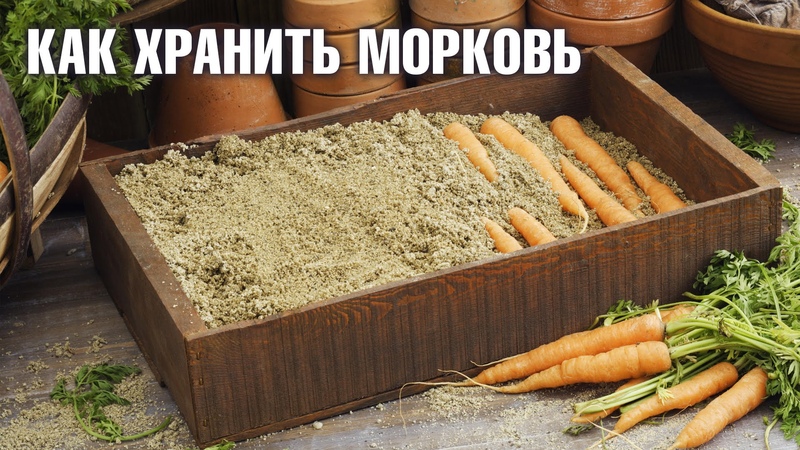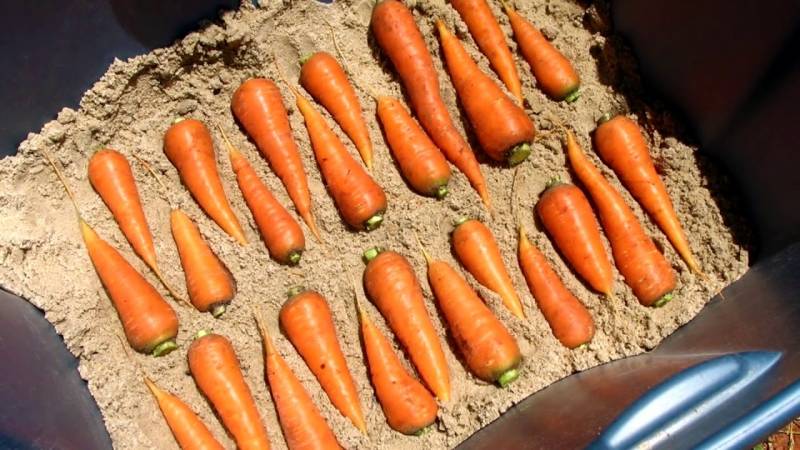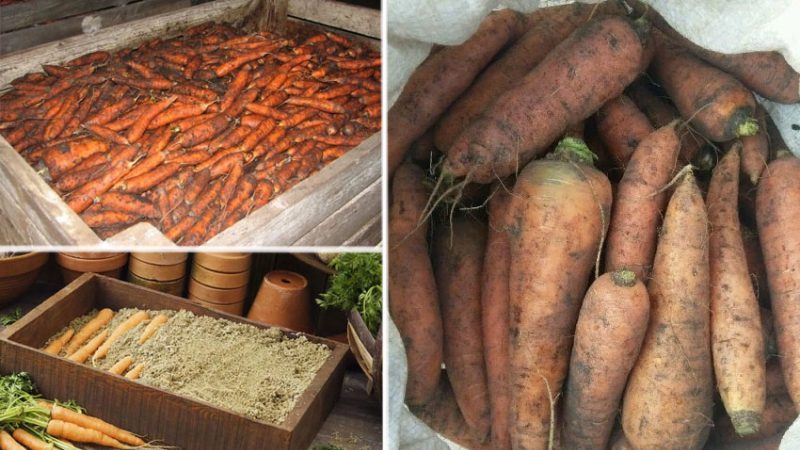Advantages and disadvantages of storing carrots in the sand, step by step instructions
Storing carrots in the sand is popular with summer residents. The sandy environment, due to its structure, regulates the air exchange process and the observance of the temperature regime in the storage tank. Using damp sand will help maintain the juiciness and firmness of the root crop due to the optimal moisture level.
From the article you will learn how to properly prepare a sandy mixture and how to store a root crop.
The content of the article
Is it possible to store carrots in the sand
Keeping carrots in winter is difficult due to their high water content and thin skin.
Sand storage - traditional way, which retains the original appearance of the crop for more than six months. The sandy environment ensures minimal losses of nutrients and the crop itself.

Points for and against
Traditionally, root vegetables in the sand are stored in a basement or cellar. Sometimes they use a balcony.
Important! Place the container of sand and carrots away from the heating system.
The benefits of keeping carrots in the sand:
- it keeps the temperature;
- maintains humidity;
- recycles carbon dioxide;
- prolongs the shelf life of the vegetable.
Disadvantages:
- contamination of root crops and the need to rinse before further use;
- time and effort spent on preparing the mixture, storage space.
Which sand to use - wet or dry
When choosing between wet and dry sand, they look at the humidity level in the room. If it is high, more than 95%, and the temperature is low - 0 ... + 2 ° С, then dry sand is used. If the basement is warm with a low level of humidity, then water is added to the sand mixture.
Raw sand allows you to maintain the elasticity of the vegetable throughout the entire storage period.
A wet sand mixture is used for the following reasons:
- it regulates the moisture level during storage;
- prevents the peel from drying out.
To moisten the sand mixture, take 1 liter of water per 10 liters of material. If, when squeezing, the sand does not crumble and does not flow out with water, then it is ready to use.
How to store carrots in the sand correctly

The vegetable is stored in a cool place with a temperature of + 0 ... + 3 ° C, observing a humidity level of 90-95%. The room is ventilated, but drafts should be avoided. It should be completely dark - in such conditions, the growth and development of the vegetable stops. For these purposes, a basement or cellar.
Important! At a temperature of + 5 ° C and above, the root crop begins to germinate.
Characteristics of storage carrots:
- mature;
- no signs of rot, disease or other flaws;
- not too juicy and tender - the rougher the carrots, the better they are stored, vitamin tender varieties best to eat first.
Preparatory stage
A wooden box, barrel, bucket, or containers will work as containers for carrots in winter. Sand is used with clay or loam. The volume is calculated as follows: take 0.5 m3 of sand for 1 kg of vegetables.

The content in the sand prevents carrots from rotting. Vegetables are prepared before storage. To do this, you should:
- Dig up the root vegetable from the soil, while not shaking or tapping it. Such methods will lead to microcracks, which will subsequently begin to rot. Carrots are harvested when 80% of the tops starts to wilt. This takes place at the end of August-September.
- Cut off the tops using a sharp knife. Do not cut it off with your hands - this will injure the vegetable.
- Rinse. This process is not required, but if the summer was rainy, then there is a high probability of rotting root crops.It is easier to view and remove diseased specimens during washing.
- Trim the carrots. Take a sharp knife and cut 2 cm below the head level. If the level of the cut is at an insufficient height, the development processes will not stop, and the root crop will germinate.
- Culling sick and crooked specimens. Straight, smooth, healthy carrots without cracks and signs of decay are sent for storage.
- Dry in a ventilated place for three hours. Avoid direct sunlight.
- Quarantine for 10 days at + 12 ° C. This is done to strengthen the skin and to detect signs of disease.
- Cull sick carrots if necessary.
Stages of preparing storage space:
- Clean and ventilate the basement.
- Wash and dry storage containers.
- Disinfect the container and the room in which the vegetables will be located.
Sand preparation stages:
- Clean and sift the sand mixture, removing all foreign elements from it.
- Moisten so that it does not crumble or flow out of the palms.
- The moisture content of the sand should not exceed 65%.
River sand is not used to keep carrots.
Storage instructions
Carrots prepared for winter storage are taken to the basement.
To keep carrots in the sand, you must:
- pour a sand mixture on the bottom of the container with a layer of 1-2 cm;
- when using a box, first cover the bottom with a cardboard or bag;
- place the carrots horizontally so that they do not touch each other and the walls of the container;
- cover a layer of carrots with sand 10 mm thick;
- repeat layers one after another until the container is full.
For vertical storage, increase the first layer of sand to 10 cm. Place the carrots upside down. They are covered with a layer of sand and the layers are repeated. The main thing is that the roots do not come into contact with each other.
Important! Place the container with root vegetables at a distance of 10 cm from the wall and, if possible, raise it above the floor. This will increase air exchange.
Shelf life of carrots in the sand

Under properly organized conditions, the shelf life of the root crop in the sand is 6-8 months.
To extend the keeping period up to 12 months, the following activities are carried out:
- sort the crop during storage in order to reject diseased specimens;
- cut off the regrown tops;
- first of all, small root crops are used, they have a short shelf life;
- do not place containers in a draft and near radiators;
- late varieties of carrots are used for storage.
To ensure a healthy harvest, chalk or well-slaked lime is mixed into the sand mixture as a preventive measure. This will give the environment antiseptic properties and prevent pathogens from developing. From the total volume of the sand mixture, it is enough to add 2% of the material.
Tips
If the harvest is small, then the question arises, how to preserve it for a long time without losing quality?
Experienced summer residents recommend:
- Do not use waterlogged sand - it will provoke carrot diseases.
- Timely sort out and remove spoiled root crops - this will extend the shelf life.
- Observe the proportions in the fertilizers. Increased doses of nitrogen and organic fertilizers will adversely affect the storage of carrots.
- Store the vegetable in a cool, high humidity environment.
- Observe cleaning times and rules vegetable trimming - all this will extend the shelf life.
Conclusion
Now you know what kind of sand to cover carrots with for the winter. During the period of its preservation in a sandy environment, the optimal conditions are the ambient temperature at + 2 ° С, the humidity level is at least 90%.
To increase the shelf life, root crops are regularly examined in order to exclude the appearance of spoilage, the regrown shoots are cut off. The implementation of these measures will allow you to maintain a high-quality harvest for a long time.